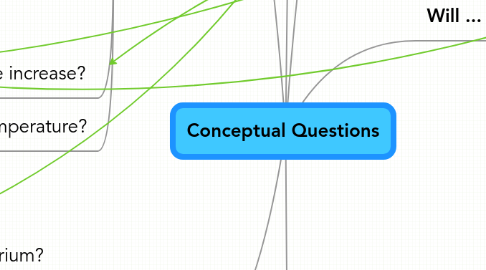
1. Why ...
1.1. are bond arranged in a particular geometry?
1.1.1. Electronic Structure
1.1.1.1. Atomic Structure
1.1.1.1.1. Orbitals
1.1.1.1.2. Valence
1.1.1.2. Molecular Structure
1.1.1.2.1. Qualitative Concepts
1.1.1.2.2. Quantum Mechanics
1.2. does entropy of the universe increase?
1.3. does rate increase with temperature?
2. When ...
2.1. will a reaction reach equlibrium?
2.1.1. Kinetics
2.1.1.1. Rate Laws
2.1.1.1.1. 0th order
2.1.1.1.2. 1st order
2.1.1.1.3. 2nd order
2.1.1.2. Reaction Mechanisms
2.1.1.2.1. Elementary steps
2.1.1.2.2. Rate-determining step
2.1.1.2.3. Rapid pre-equilibrium
2.1.1.3. Arrhenius Model of Chemical Kinetics
2.1.1.3.1. Temperature dependence
2.1.1.3.2. Activation energy
2.1.1.3.3. Pre-exponential factor A
2.1.1.4. Transition State Theory
2.1.1.4.1. Reaction diagram
2.1.1.4.2. Temperature dependence of activation free energy
2.2. does the autodissociation of water change pH?
2.2.1. pH of dilute solutions
2.3. is an acid or base considered to be strong?
2.3.1. Relative strengths
2.3.2. Conjugate acids/bases
2.3.3. Ka, Kb, Kw
3. is a reaction spontaneous?
3.1. Thermodynamics
3.1.1. Gibbs Free Energy
3.1.1.1. Enthalpy
3.1.1.1.1. Hess's Law
3.1.1.1.2. Heats of formation
3.1.1.1.3. bond dissociation energies
3.1.1.2. Entropy
4. How ...
4.1. are bonds in a molecule formed?
4.1.1. Molecular Structure
4.1.1.1. Qualitative Concepts
4.1.1.1.1. Octet Rule
4.1.1.1.2. Lewis Dot
4.1.1.1.3. Localized electrons
4.1.1.1.4. VSEPR
4.1.1.2. Quantum Mechanics
4.1.1.2.1. Hybridization
4.1.1.2.2. Molecular Orbitals
4.1.1.2.3. Schrödinger Equation
4.2. are bonds oriented?
4.3. is electronic structure quantized?
4.3.1. Spectroscopy
4.3.1.1. NMR
4.3.1.2. IR
4.3.1.3. UV-Vis
4.3.1.4. microwave
4.4. does a reaction take place (what is the mechanism)?
4.4.1. Reaction Mechanisms
4.4.1.1. Elementary steps
4.4.1.2. Rate-determining step
4.4.1.3. Rapid pre-equilibrium
5. Will ...
5.1. a reaction occur (eventually)?
5.1.1. Spontaneity
5.1.1.1. 2nd Law of Thermo
5.1.1.2. Standard Free Energy
5.1.1.3. Standard Reaction Changes
5.1.1.3.1. Hess' Law
5.1.1.3.2. Enthalpies & Free Energies of Formation
5.1.1.3.3. Third Law of Thermo
5.2. work be done by or on the system?
5.2.1. Energy
5.2.1.1. Kinetic
5.2.1.2. Potential
5.2.1.3. work
5.2.1.3.1. PV Work
5.2.1.4. heat
5.3. heat flow to or from the system?
5.4. shift left or right?
5.4.1. Equilibria
5.4.1.1. Q: reaction quotient
5.4.1.2. Equilibrium Constant
5.4.1.2.1. .
5.4.1.2.2. Activity
5.4.1.3. Le Châtelier's Principle
5.4.1.3.1. Effect of changing conditions on equilibrium position
5.4.1.4. Acid/Base Equilibria
5.4.1.4.1. pH
5.4.1.4.2. Ka, Kb
5.4.1.4.3. pKa
6. What ...
6.1. is the structure of reactants or products?
6.1.1. Spectroscopy
6.1.1.1. NMR
6.1.1.1.1. number of chemically distinct protons
6.1.1.2. IR
6.1.1.2.1. bond strength, reduced mass
6.1.1.3. UV-Vis
6.1.1.3.1. electronic spacing
6.1.1.4. microwave
6.1.1.4.1. bond length
6.1.2. Polarity
6.1.2.1. bond polarity
6.1.2.2. molecular polarity (dipole moment)
6.2. is the relationship between energy and mechanism?
6.3. is the heat of a reaction?
6.3.1. Calorimetry
